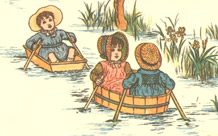
Illustration by Kate Greenaway.
Rare books exhibition celebrates children's enduring love of reading
The University of Exeter has teamed up with Devon County Council’s Exeter Central Library to launch an exhibition of early children’s literature from 3 April – 31 May.
Girls and Boys of Storyland has been funded by South West Regional Library Service (SWRLS) and will showcase rare items from the library and university’s Special Collections, giving visitors of all ages the unique opportunity to see rhymes, stories and illustrations from nineteenth and early twentieth century books and periodicals.
The displays at the library and the University will feature a host of familiar character from Margery Meanwell (aka Goody-Two Shoes) to Matt Merrythought (the boy who was always happy) as well as some forgotten children’s books like The Travellers by Mrs Arthur Gaskin (the pen name of Georgie Evelyn Cave Gaskin) and favourites like The Would-Be-Goods, Alice in Wonderland and Little Lord Fauntleroy, and some local characters like Six Devonshire Dumplings and The Devon Boys. There will be the chance to see beautiful illustrations, including images by Walter Crane, Kate Greenaway and Arthur Rackham.
There will also be a range of Victorian children’s fiction from the Chris Brooks Collection, as well as books of children’s poetry from the working library of John Betjeman. Classics such as Charles Kingsley’s The Water Babies will be on show alongside works by Emma Marshall, L.T. Meade and Mrs Molesworth, who were extremely popular in their own time, but may be less familiar to readers now. Another highlight will be the opportunity to see Victorian periodicals for children, such as the Girl’s Own Paper and Boy’s Own Paper.
A series of events will take place during the exhibition period, including ‘Who Lives in Storyland?’ - a free family drop-in print workshop by local printers Double Elephant which will take place at Exeter Central Library from 10am – 3pm on Tuesday 3 April.
Dr Maeve Pearson, an expert on children’s literature and culture from the University of Exeter, will also be giving two talks during the exhibition period. She will be in The Music Room at Exeter Central Library on Saturday 21 April at 2pm and the Margaret Rooms of the Queen's Building at University of Exeter Streatham Campus on Thursday 10 May at 5.30pm. Tickets should be booked in advance at www.girlsandboysinstoryland.eventbrite.co.uk.
Dr Christine Faunch, Head of Heritage Collections and Cultural Services at the University of Exeter said: “This is a wonderful opportunity for the two libraries to work together to raise the profile of these fascinating and important collections.
“Most of us have powerful connections with children’s literature: memories of our own childhood favourites, an ongoing love of children’s books, or a desire to engage new readers in the pleasures of stories and pictures. Educationally and culturally important, children’s literature is also of enduring interest to many scholars.”
Councillor Roger Croad, Devon County Council Cabinet Member with responsibility for libraries said: “Both Exeter Central Library and the University of Exeter have exciting and diverse collections of early children’s book throughout the 1800s so it is excellent news that, thanks to this valuable partnership with the university and funding from the South West Regional Library Service (SWRLS), we are able to showcase the highlights from each, and offer residents the opportunity to see this enduring material which is of educational and cultural importance.”
Demelza Hookway, Project Officer and University of Exeter English PhD student added: “It has been a great experience to work with colleagues from both libraries, in order to put the exhibitions together. In our increasingly digitised culture, it's a privilege to work with the rare materials from these collections and to think about the social and educational value of printed books. I'm hoping that visitors to the exhibitions will be impressed by the range of images and formats produced for children in the nineteenth and early-twentieth centuries.”
Date: 2 April 2012
